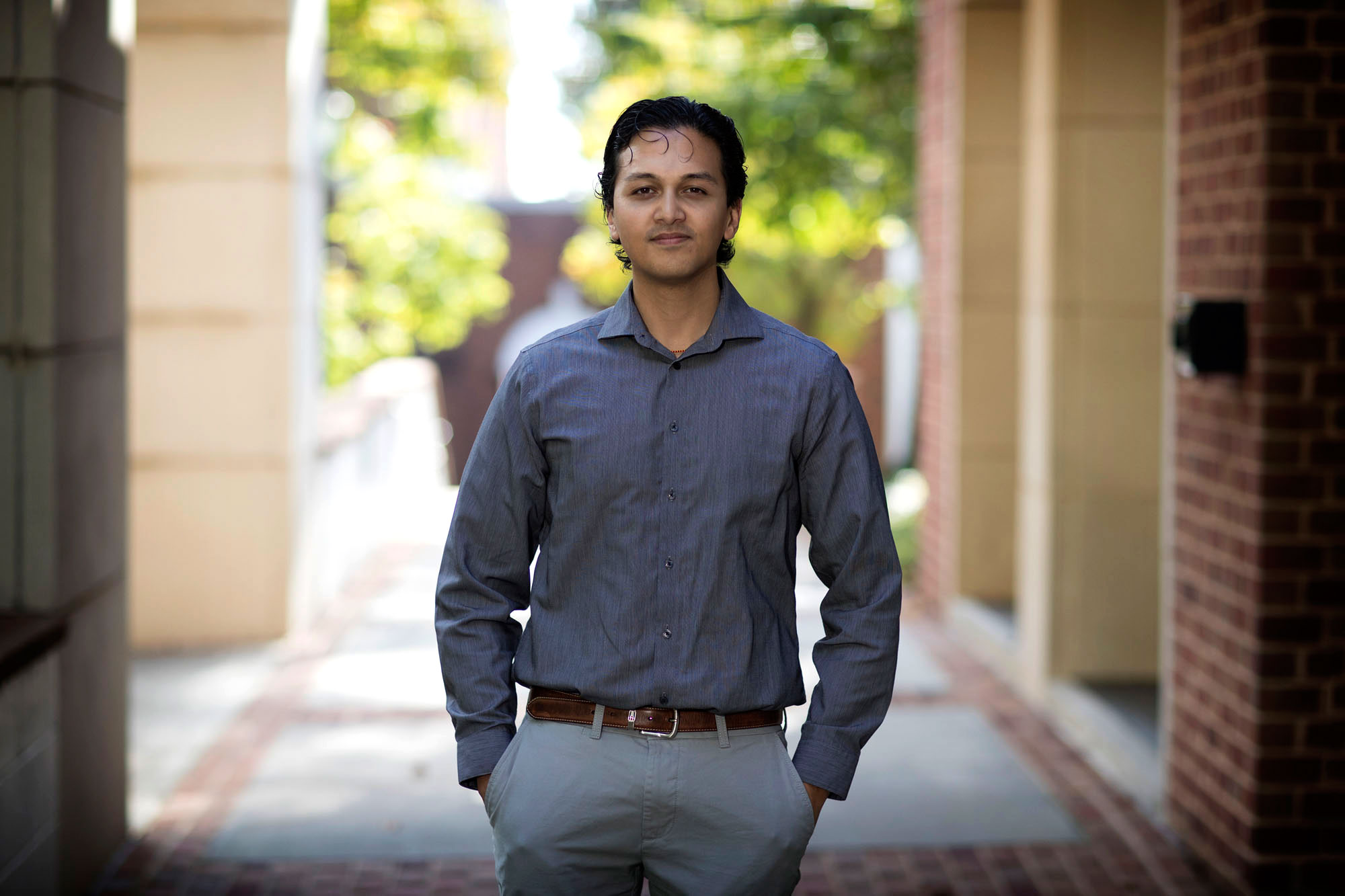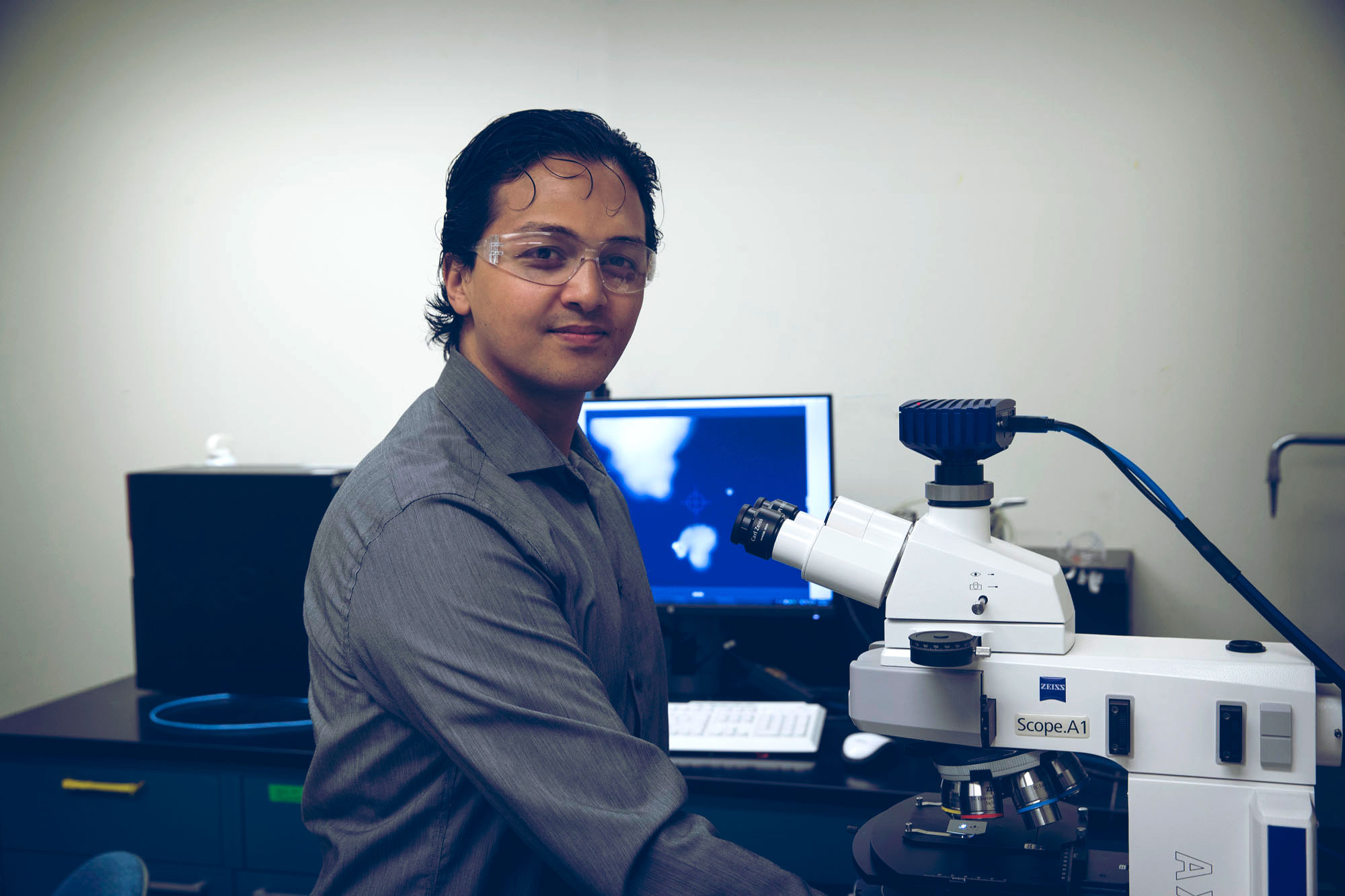Gaurav Giri can see the possibilities.
“The dawn of next-generation electronics is approaching,” he said. “Imagine never missing a moment, when every mirror and windowpane can be used as a television. Imagine being able to just roll up or fold your smartphone or tablet like a piece of paper to store in your wallet. Imagine electronics being able to smell things, determine the texture of things. Clean solar energy becomes easy when any surface can store energy; from walls and curtains, to shirts and pants, you will never run out of battery again. The possibilities are endless.”
Now he’s trying to make some of those things happen in his lab at the University of Virginia.
Giri, 30, came to the University last year as an assistant professor of chemical engineering after receiving a Ph.D. at Stanford University in 2013. He teaches modeling and simulations for undergraduate chemical engineering majors, and researches organic crystals for use in pharmaceuticals, metal organic frameworks and organic electronics.
Currently, electronics use transistors fabricated on single crystal silicon substrates, in order to take advantage of the electrical properties of silicon. With organic semiconductors, transistors could be made on other substrates and not have to be limited by silicon. “Organic semiconductors” are organic molecules, based on carbon, hydrogen and oxygen. that form a solid state in a periodic manner, which makes them crystals. The crystals grow using different methods, such as growing them from solution. These organic semiconductors allow designers to use other systems, such as plastic, glass, paper and fabric, to give electronics increased flexibility and functionality.

Giri is researching new organic crystals for use in pharmaceuticals, metal organic frameworks and organic electronics.
“If you fabricate these electronics on clear plastic or glass, you have transparent electronics, with the same electronic functionality, but also the added functionality for glass,” he said. “If you have solar cells made out of plastic, you don’t have to have these giant silicon panels across the roof of your house; any surface can be covered with flexible, plastic photovoltaics.”
Organic electronics and metal organic frameworks are recent materials. “Traditionally, the crystallization of organic materials has been studied using techniques established in materials science or chemistry,” he said.
He notes that his lab is taking a multi-disciplinary approach. “I come from a background in chemical engineering, which allows me to bring in a new and interesting set of expertise to the field,” he said.
This fall, Giri will be focused on establishing his lab at UVA with three graduate students, a post-doctoral scholar and three undergraduates.
“We are making organic crystals for organic electronics and pharmaceutical applications. We can study them here, and use them for applications,” Giri said. “But to get detailed crystal information, we need to travel to a synchrotron facility.” The Giri lab books time on the Cornell High Energy Synchrotron Source at Cornell University in Ithaca, New York, which produces X-rays they can use to study crystals.
Giri, who moved to the United States from Nepal when he was 14, says he is doing everything he wants right now.
“I love my research,” he said. “I get to work in this new, exciting field that can change our lives completely. I don’t think anybody yet truly understands the reach of this field because we are just now beginning to solidify the first few applications of organic electronics and metal organic frameworks. In the coming years, our lives and our children’s lives may be completely different because of the new technology available.
“My driving force is to be part of this technological revolution, to contribute to the new age of material science and electronics. And I will definitely have fun doing it.”
As a new professor, Giri feels right at home at UVA. He was drawn to the Grounds because the academic environment was a good fit for him.
“The department personality is great,” he said. “Everybody hangs out together, we eat lunch together, and everybody is very helpful. It is a very young department right now, and there are a lot of good collaborations.”
He was also impressed with the student involvement.
“When I interviewed, the undergrads actually wanted to talk with me as well,” Giri said. “That is not something I would normally expect. When I was an undergraduate, I didn’t know who the new incoming professors were before I took classes with them. It speaks volumes about the culture at UVA and the strong connection between administration and students, when the undergraduate students can and do get to know new professors like me. It feels so rewarding to teach students who are so invested and involved in their education, and it is amazing to see them grow with each coming year.”
The students he taught last year are back as third-year students. “I can see their thought process, see how they solve problems, and see how they interact with problems,” he said. “When they understand more about the field of chemical engineering, they can have more creative ideas.”
Giri said there are many challenges in the field, and he enjoys introducing these challenges to the next generation of engineers.
“As chemical engineers, we need to understand materials science, thermodynamics, fluid dynamics and chemistry, among others, and how to combine all that information in novel ways to understand the real world,” he said. “There is a reason why chemical engineers are widely sought-after in industry. I am proud to help the undergraduate and graduate students reach that level of excellence.”
Editor’s note: This is another installment in an occasional series profiling members of a generational wave of new faculty members at the University of Virginia.
Media Contact
Article Information
October 6, 2016
/content/professor-splits-time-between-opening-minds-teaching-and-researching-crystals


